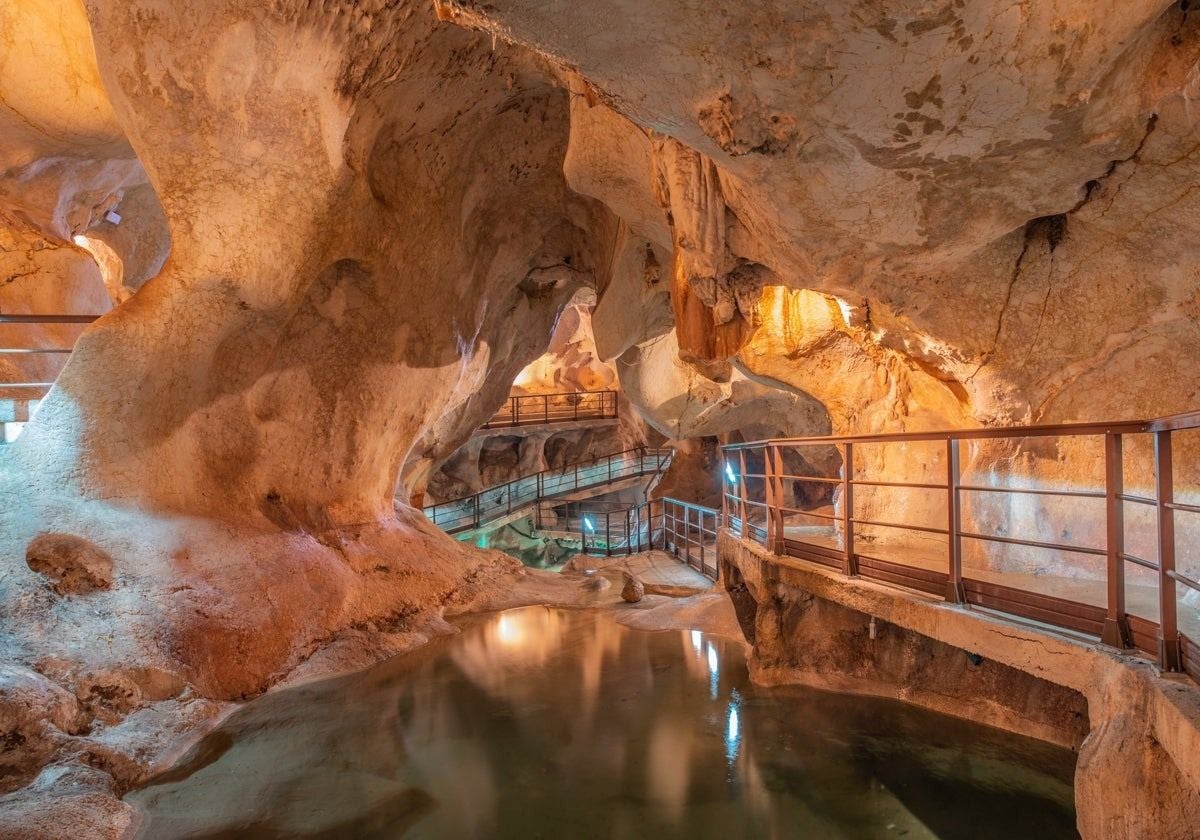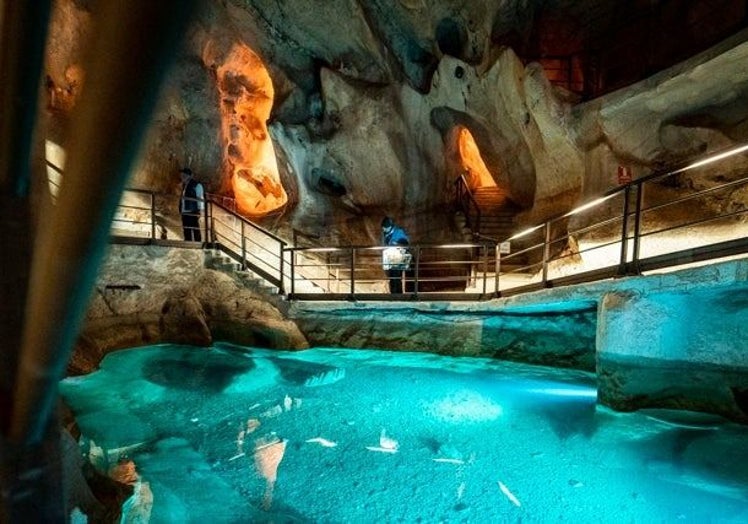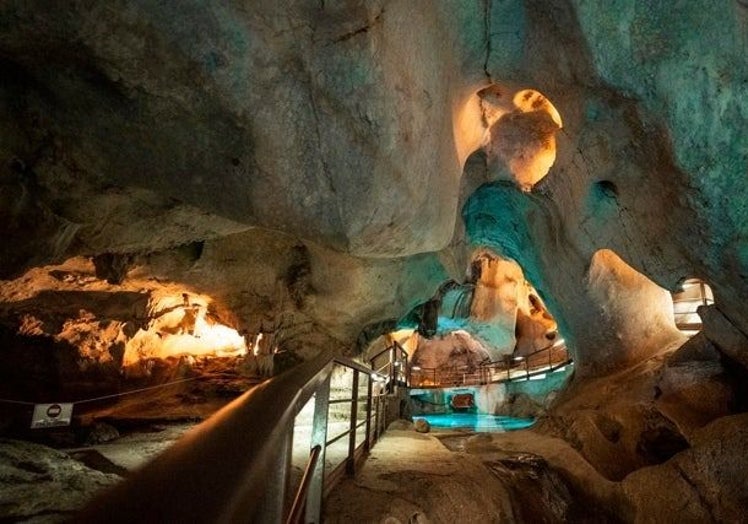

Sections
Highlight

María Alonso
Malaga
Monday, 31 March 2025, 16:53
Just fifteen kilometres from Malaga city, in Rincón de la Victoria on the eastern Costa del Sol, lies the Cueva del Tesoro, one of only three visitable underwater caves in the world and the only example of its kind in Europe. Declared a natural heritage site, it is a must-see for visitors to the area, as history, archaeology and legend come together in this place to offer an unforgettable experience.
Located on a cliff, the sea water has sculpted this site since Jurassic times, creating a network of underground galleries. Its impressive formation is thanks to the effect of the sea on the rocks, which over the years has created cracks, columns, stalactites, stalagmites and spectacular gorges.
Human remains, animals and pottery from the period known as the Neolithic Cave Age have been found inside. In addition, Palaeolithic and Bronze Age remains were found in its galleries, as well as samples of rock art.
Accessing the cave is a unique experience. The entrance is surrounded by Mediterranean vegetation, which gives way to a more sombre and mysterious atmosphere as you go deeper into the cave. As visitors enter, the stalactite and stalagmite formations are revealed in all their splendour. The immaculate white walls reflect the artificial light, creating a magical, almost dreamlike atmosphere.
A tour of the cave is not only a visual treat, but also a journey back in time. During the visit, you can see the traces of ancient inhabitants who used the place as a shelter, and the specialised guides tell fascinating stories about the geological evolution of the space, as well as the historical and cultural importance of the cave.
The visit begins with an exhibition of archaeological remains in La Sala de la Virgen, which is also home to the Swiss Well, created by Antonio de la Nari. We continue through the Marcus Crassus hall, so called because it is the location of his hiding place during his escape from the persecution by Marius and Cinna.

Continuing on, in the Sala del Águila (eagle hall) sits a large rock in the shape of this bird of prey, and then continuing through the Labyrinthine Galleries, you arrive at the Sanctuary of Noctiluca, goddess of the moon, of the night, of fertility?
Finally, through this wing, the visitor enters the 'volcano' gallery, where there is a hollow that ends in a chasm which probably reaches the sea. If you return to the Sala de la Virgen, you can go on to the beautiful Sala de los Lagos (Hall of the Lakes), which is particularly majestic.
Among the cave's treasures there are cave paintings, Neolithic pottery and arrowhead points, hatchets, polished knives, bracelets, harpoons and Phoenician and Arabic remains.
It is said that in the year 86 BC, Marcus Crassus, fleeing from the persecution of Marius and Cinna, hid there for a few months. Plutarch already mentions the existence of this cave, and this is recorded in 1789 by Cecilio García de la Leña in his work 'Conversaciones Históricas Malagueñas' (Historical conversations in Malaga).
But long before it was known that the Cueva del Tesoro was unique in Europe and that there are only two others of its kind in the world, it had a strong mystical character for centuries. The inhabitants of the area attributed magical, strange, "paranormal phenomena" to its surroundings, with the existence, they say, of "numerous apparitions".
In recent centuries, the legend of the impressive treasure hidden in the 12th century by Arabs who had fled from the uprisings in their homeland, has attracted the attention of locals and foreigners alike. This is where the legends differ, but only in terms of authorship: some say that it was five Moorish kings who arrived in Malaga laden with enormous riches, which they hid in the the cave; other versions say that it was the emperor of the Almoravids, Tasufín Ibn Alí who was the possessor of the treasure.

From the 17th century onwards, parties of discoverers started to visit the cave who altered the conditions in which it was found. However, these alterations were carried out on top of earlier ones, which further fuelled the belief that the purpose of these alterations was to conceal the great treasure. When a series of garnets appeared in the Cave in the 18th century, there was little doubt that the legends about the treasure were true.
The Cueva del Tesoro is located just 15 kilometres from Malaga city, making it an accessible visit for both locals and international tourists. It can be easily reached by car or by public transport, with bus options connecting Rincón de la Victoria with Malaga city. Once in the municipality, the signposting to the cave is clear and facilitates access for visitors.
The Cueva del Tesoro is suitable for the whole family and most areas of the cave are accessible. Access for people with disabilities is only possible in the visibility of the Hall of the Virgin, by means of a lift. After that, mobility is very limited and includes flights of stairs.
The audio tour is possible by downloading an app on your device. The use of headphones is recommended. There is no additional cost.
Free visits are available from Monday to Friday and the cave and the opening times are: from 1 October to 30 April 10 am to 1pm and from 3pm to 5pm. From 1 May to 30 September from 10.30am to 1pm and from 4.30 pm to 7pm. The cave is closed on 24, 25 and 31 December, and on 1 and 6 January.
Publicidad
Publicidad
Publicidad
Publicidad
Esta funcionalidad es exclusiva para registrados.
Reporta un error en esta noticia

Debido a un error no hemos podido dar de alta tu suscripción.
Por favor, ponte en contacto con Atención al Cliente.

¡Bienvenido a SURINENGLISH!

Tu suscripción con Google se ha realizado correctamente, pero ya tenías otra suscripción activa en SURINENGLISH.
Déjanos tus datos y nos pondremos en contacto contigo para analizar tu caso

¡Tu suscripción con Google se ha realizado correctamente!
La compra se ha asociado al siguiente email
Comentar es una ventaja exclusiva para registrados
¿Ya eres registrado?
Inicia sesiónNecesitas ser suscriptor para poder votar.